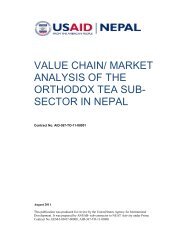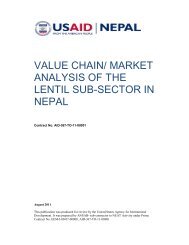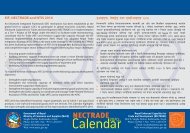value chain/ market analysis of the ginger sub-sector ... - Nepal Trade
value chain/ market analysis of the ginger sub-sector ... - Nepal Trade
value chain/ market analysis of the ginger sub-sector ... - Nepal Trade
- No tags were found...
You also want an ePaper? Increase the reach of your titles
YUMPU automatically turns print PDFs into web optimized ePapers that Google loves.
yielding varieties and improved cultivation practices like use <strong>of</strong> quality seeds, propermulching, weeding, and disease management.Mo<strong>the</strong>r rhizome harvesting: There is <strong>the</strong> practice <strong>of</strong> mo<strong>the</strong>r rhizome harvesting in easternpart <strong>of</strong> <strong>the</strong> country which is not practiced by <strong>the</strong> farmers <strong>of</strong> central and western <strong>Nepal</strong>. Theharvesting <strong>of</strong> mo<strong>the</strong>r rhizome can provide significant return in cost <strong>of</strong> production as it is soldin <strong>the</strong> <strong>of</strong>fseason.5.2.3 ProcessingProduct diversification: This study objectively looks at developing <strong>value</strong> added products indifferent <strong>value</strong> <strong>chain</strong> points <strong>of</strong> <strong>ginger</strong> for better <strong>market</strong> penetration and economic gain <strong>of</strong> <strong>the</strong>primary producers. It is found that departmental stores in Kathmandu are importing <strong>ginger</strong>products like paste, powder, slices mixed with vinegar, etc. from India and Thailand. Apartfrom that <strong>the</strong>re is also high demand <strong>of</strong> powder, pickles, and dry <strong>ginger</strong>. If <strong>Nepal</strong>eseprocessors can make those products, <strong>the</strong>y will easily access <strong>the</strong> <strong>market</strong>, which is morepr<strong>of</strong>itable than selling it fresh.Availability <strong>of</strong> o<strong>the</strong>r projects: There is availability <strong>of</strong> program and projects like CADP,PACT, HVAP, Mercy Corps, SNV, and WTO-STDF which are focussing <strong>the</strong>ir activities in<strong>the</strong> <strong>ginger</strong> <strong>sector</strong>. Greater collaboration would result in meaningful, easy access to processingactivities at farmers and traders level.5.2.4 MarketingValue addition through cleaning, grading & sorting: To make <strong>the</strong> products competitive inregional <strong>market</strong>s, simple activities like cleaning, grading, sorting, and proper packaging canbe done. These activities would increase <strong>the</strong> shelf life <strong>of</strong> <strong>the</strong> products and help generatepremium price in <strong>the</strong> <strong>market</strong>s.Opportunity for import <strong>sub</strong>stitution: As <strong>Nepal</strong> is exporting fresh <strong>ginger</strong> at a low price andimporting <strong>value</strong> added products from regional and international <strong>market</strong> at a high price, <strong>the</strong>reis an opportunity to <strong>sub</strong>stitute <strong>the</strong> imports. For example, <strong>Nepal</strong> is also importing fresh <strong>ginger</strong>from China, which can be <strong>sub</strong>stituted by developing storage facilities.Market diversification: Most <strong>of</strong> <strong>the</strong> <strong>ginger</strong> from <strong>Nepal</strong> is exported to India. ITC data showsthat about 99 percent <strong>of</strong> <strong>ginger</strong> was exported to India in 2009, however, per unit price <strong>of</strong><strong>ginger</strong> in Indian <strong>market</strong> is low compared to o<strong>the</strong>r South Asia, East Asian and Middle Eastcountries. According to ITC 2010, <strong>the</strong> exported unit <strong>value</strong> (USD/MT) for <strong>Nepal</strong>ese <strong>ginger</strong> inIndia is USD 205. In this context, <strong>the</strong> <strong>market</strong> diversification can be a good opportunity for<strong>Nepal</strong>ese <strong>ginger</strong>. South Asian countries like Pakistan and Bangladesh are <strong>the</strong> 3 rd and 5 thbiggest importers <strong>of</strong> <strong>the</strong> <strong>ginger</strong> worldwide and have imported <strong>ginger</strong> with <strong>the</strong> unit <strong>value</strong> <strong>of</strong>USD 878 and USD 1,556 respectively. Similarly, Arabian countries, Japan, Malaysia, USA,UK and Ne<strong>the</strong>rlands can be <strong>the</strong> potential <strong>market</strong>s for <strong>the</strong> export <strong>of</strong> <strong>Nepal</strong>i <strong>ginger</strong>, as <strong>the</strong>yhave good demand <strong>of</strong> <strong>ginger</strong> with high unit <strong>value</strong>.Employment for women and poor in primary processing center: In <strong>the</strong> eastern region, <strong>the</strong><strong>ginger</strong> from <strong>Nepal</strong> is washed in Naxalbari, a bordering town in India. No such processingcentre is reported in <strong>the</strong> western region. According to an exporter in Naxalbari, a singleprocessing center can provide employment to approx 50 people for 10 months. Most <strong>of</strong> <strong>the</strong>workers in such processing centers are found to be women or <strong>the</strong> poor. Establishment <strong>of</strong> suchValue Chain/Market Analysis-Ginger 33






